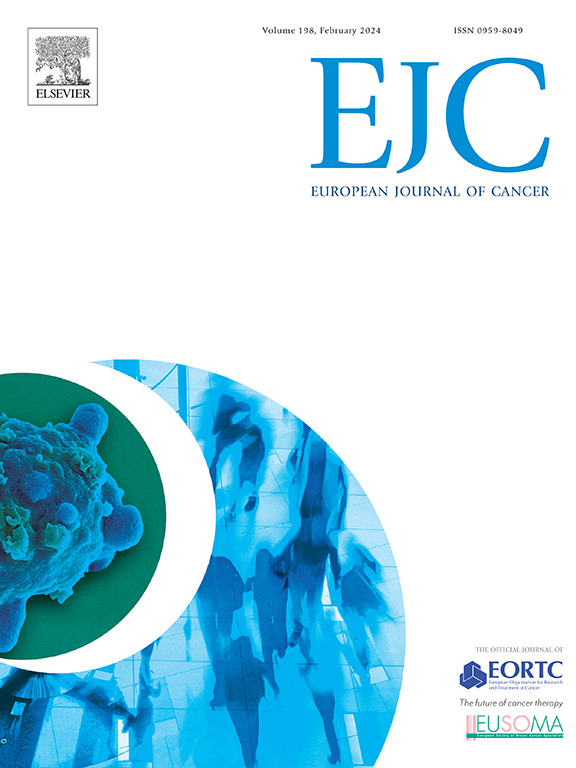辅助生殖技术在年轻BRCA携带者乳腺癌后怀孕:一项国际队列研究
IF 7.6
1区 医学
Q1 ONCOLOGY
引用次数: 0
摘要
关于BRCA1/2携带者在乳腺癌后怀孕中使用辅助生殖技术的数据非常有限。本研究旨在探讨ART在BRCA1/2携带者乳腺癌后实现妊娠的安全性。方法:这是一项国际性的、以医院为基础的回顾性队列研究,研究对象为2000年至2020年间年龄≤ 40岁、既往乳腺癌诊断后怀孕的BRCA1/2携带者。比较年轻BRCA1/2携带者使用ART和自然受孕的结果。结果543例乳腺癌后妊娠的BRCA1/2携带者中,436例为自然妊娠,107例为ART妊娠。在接受ART治疗的107例妊娠中,45例(42.1 %)在诊断时使用卵母细胞/胚胎冷冻保存,33例(30.8 %)在接受体外受精/卵浆内单精子注射或宫内授精诱导排卵或抗癌治疗后计划性交后获得,21例(19.6 %)在卵母细胞捐赠后获得,8例(7.5 %)患者未接受ART治疗。与未接受抗逆转录病毒治疗的患者相比,接受抗逆转录病毒治疗的患者在受孕时年龄更大,患激素受体阳性乳腺癌的频率更高,从癌症诊断到受孕的中位时间更长。在受孕后5.2年的中位随访中,没有观察到ART对无病生存的明显不利影响(调整后HR=0.72, 95 % CI 0.39-1.34)。结论在乳腺癌后怀孕的年轻BRCA1/2携带者中,ART的使用似乎与DFS事件的风险增加无关。本文章由计算机程序翻译,如有差异,请以英文原文为准。
Assisted reproductive technology in young BRCA carriers with a pregnancy after breast cancer: An international cohort study
Introduction
Very limited data exist on assisted reproductive technology (ART) use in BRCA1/2 carriers conceiving after breast cancer. This study aimed to investigate the safety of ART to achieve a pregnancy after breast cancer in BRCA1/2 carriers.
Methods
This is an international, hospital-based, retrospective cohort study including BRCA1/2 carriers with a pregnancy after prior breast cancer diagnosis at ≤ 40 years of age between 2000 and 2020. Outcomes were compared between young BRCA1/2 carriers who conceived using ART and those who conceived spontaneously.
Results
Among 543 BRCA1/2 carriers with a pregnancy after breast cancer, 436 conceived spontaneously and 107 using ART. Of 107 pregnancies achieved with ART, 45 (42.1 %) were obtained using oocytes/embryo cryopreserved at diagnosis, 33 (30.8 %) after controlled ovarian stimulation for in-vitro-fertilization/intracytoplasmic sperm injection or ovulation induction for intrauterine insemination or planned intercourse after anticancer treatments, 21 (19.6 %) after oocyte donation, while for 8 (7.5 %) patients type of ART was missing. Compared to patients in the no-ART group, those in the ART group were older at the time of conception, had more frequently hormone receptor-positive breast cancer and a longer median time from cancer diagnosis to conception. At a median follow-up of 5.2 years after conception, no apparent detrimental effect of ART on disease-free survival was observed (adjusted HR=0.72, 95 % CI 0.39–1.34).
Conclusion
In young BRCA1/2 carriers with a pregnancy after breast cancer, ART use did not appear to be associated with increased risk of DFS events.
求助全文
通过发布文献求助,成功后即可免费获取论文全文。
去求助
来源期刊

European Journal of Cancer
医学-肿瘤学
CiteScore
11.50
自引率
4.80%
发文量
953
审稿时长
23 days
期刊介绍:
The European Journal of Cancer (EJC) serves as a comprehensive platform integrating preclinical, digital, translational, and clinical research across the spectrum of cancer. From epidemiology, carcinogenesis, and biology to groundbreaking innovations in cancer treatment and patient care, the journal covers a wide array of topics. We publish original research, reviews, previews, editorial comments, and correspondence, fostering dialogue and advancement in the fight against cancer. Join us in our mission to drive progress and improve outcomes in cancer research and patient care.
 求助内容:
求助内容: 应助结果提醒方式:
应助结果提醒方式:


